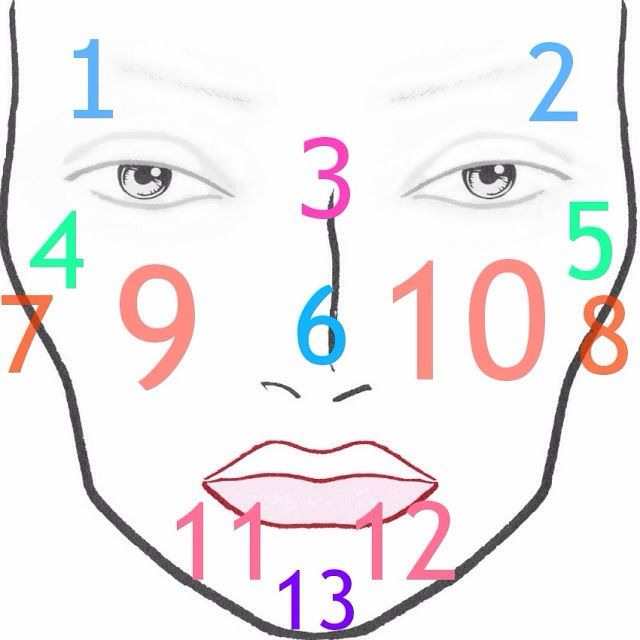
Your skin can say a lot about your health especially about your face. It’s viewed as the mirror to our health. Can you tell I have a mild fascination with non-traditional alternative medicine? First, I mentioned the Ayurvedic (Indian) medicine method of dry skin brushing, and today, I want to talk about face mapping. This practice, falls under the umbrella of ancient traditional Chinese medicine (TCM.)

TCM is based mainly on the prevention of illness, uses herbs, acupuncture, acupressure, massage, exercise, and diet to promote good health. It especially emphasizes changing lifestyle habits. The key to understanding Chinese medicine is to understand the idea of balance.

It seems that since I have become a woman of a certain age with constant hormonal changes, I now experience bouts of acne. I haven’t been interested in taking the hormone replacement therapies (HCT), so I have found relief from hot flashes, adult acne and losing my hair from natural sources.
Since this post is focusing on acne, I will keep the discussion to that of my face. So back to the face mapping that I mentioned earlier.

What shows up on your face is directly or indirectly connected to the state of your internal organs and systems, making our skin one of the greatest mirrors to inner imbalances. Face Mapping is the chances diagnostic tool that has been used in China and India and is a great way to determine where skin symptoms (pimple, rash, redness, hyper pigmentation, sallowness, darkness or wrinkle) connects deeper in the body, helping to determine the cause of one’s skin care woes.
The Face Mapping numbered photo above corresponds with the information listed below:
Zone: 1 & 2: Digestive System – avoid processed foods and opt for fresher, natural alternatives. Eat slower and chew food well and increase your fiber intake. Don’t forget to drink plenty of water as well.
Zone 3: Liver – reduce alcohol, greasy food and dairy intake which all put a strain on the liver. This is the zone where food allergies might show up. Again, drink plenty of water to cleanse the system and get plenty of sleep, your liver needs rest too.
Zone 4 & 5: Kidneys – Anything around the eyes (including dark circles) point to dehydration. Drink up!
Zone 6: Heart – This can indicate high blood pressure and Vitamin B deficiency so get your blood pressure checked and consider a vitamin supplement. Try to avoid too much spicy food and cut down on meat intake. Look into ways to lower cholesterol, like replacing “bad fats” with “good fats” such as Omega 3 and 6 found in nuts, avocados, fish, and flax seed and finally get some fresh air.
Zone 7 & 8: Kidneys – Again, drink up! And cut down on soft drinks, coffee and alcohol as these cause further dehydration.
Zone 9 & 10: Respiratory system – Do you smoke? Have allergies? Or are you suffering from a bronchial cold or asthma? This area is affected by the lungs. Keep your body cool and don’t let it overheat, eat more cooling food and get more fresh air. Keep the body more alkaline by avoiding foods that make the body acidic (meat, dairy, alcohol, caffeine, sugar) and adding more alkalizing foods like green veggies.
Zone 11 & 12: Hormones – This is the zone for stress and hormonal changes. And while both are sometimes unavoidable, you can decrease their effect by getting adequate sleep, drinking enough water, eating leafy veggies and keeping skin scrupulously clean. Another interesting point: breakouts in this zone indicate when you are ovulating (and on which side).
Zone 13: Stomach – Step up the fiber intake, reduce the toxin overload and drink herbal teas to help with digestion.
Zone 14: (not shown above, zone 14 is the neck area) Breakouts here can be a sign that your body is fighting bacteria to avoid illness. Rest and recuperate. Eat well, drink plenty of water, find ways to relax and get plenty of sleep. Allow your body to fight back by treating it well.
So the next time you break out or notice puffiness, dryness or dark under-eye circles, look to your face map: your skin is probably trying to communicate on behalf of the internal organs. However, do remember that, as with all medical issues, it is always best to see your doctor for proper diagnosis. This is just a general guide to point you in the right investigative direction – just because you break out between the brows doesn’t necessarily mean you have a bad liver.
Perhaps you don’t get breakouts or breakouts only during that certain time of the month. However, once again I hope you find this information about Face Mapping not only interesting but helpful.
